Recycling Batteries, a growing problem.

In 2010 regulations came into force requiring the UK to recycle 45% of batteries placed on the market by 2016. This equates to 500 million batteries. This follows the 2006 EU Battery Directive that set a target of 25% of all batteries to be collected by 2012.

The Batteries and Accumulators and Waste Batteries and Accumulators Directive (2006/66/EC) aims to improve the environmental performance of batteries and accumulators and minimise the impact that waste batteries and accumulators have on the environment.
The Directive places requirements on the design of all new batteries, and requires the separate collection, treatment and recycling of waste batteries and accumulators, reducing the disposal of batteries and accumulators in the municipal waste stream.
The Batteries and Accumulators (Placing on the Market) Regulations 2008 implement the above Directive by setting out the technical requirements which any person wishing to place on the market new primary single use batteries and accumulators ie rechargeable batteries and appliances that contain batteries and accumulators.
These Regulations restrict the use of mercury and cadmium, introduce labelling requirements ( crossed out wheelie bin symbol), placing on the market and requirements for appliances to be designed in such a way that waste batteries can be readily removed. The Regulations place different obligations on batteries that are classed as:
· Industrial: used in off shore oil rigs, barcode readers, professional video and golf trolleys
· Automotive: used for the starting or ignition of an engine of a road going vehicle but not to power an electric vehicle.
· Portable: Sealed and can be hand carried by an average natural person without difficulty such as AA, AAA or batteries used to power a laptop or mobile phone
The 2009 Batteries and Accumulators Regulations, place differing obligations on Producers and Distributors.
For example, producers who expect to place more than 1 tonne on the market must join a Battery Compliance Scheme that covers registration, reporting of sales data, publicity and collection and treatment and recycling. Distributors who supply 32 kilograms or more of batteries must accept back waste portable batteries from end – users without charge.
Types of battery
Most types of batteries can be recycled.
- Lead-acid: include car batteries, golf trolleys, industrial fork lift, motorcycle batteries. These are recycled by grinding, neutralising the acid and separating the polymers from the lead, which can be recycled. This is a simple process and generally can be conducted in a profitable manner.
- Silver Oxide: used in medical devices, toys and watches. These contain mercury that become hazardous on the onset of leakage.
- Lithium and Lithium – Ion: As the price of Li – Ion batteries falls to permit the development of electric vehicles, the value of the recovered materials also falls. The process of recycling Li- Ion batteries is complex and expensive and is based on recovering cobalt
- Zinc Carbon, for example torch batteries, used in low drain clocks and radios, often replaced by alkaline batteries, cells and rechargeable NiMH batteries.
The Impact of Batteries [China]
In 2005, over 30 billion batteries were produced globally, almost half in China; even if many are recycled after first use, many still enter the waste stream. Lead acid batteries are ‘recycled’ in crude small scale operations where approximately 50% of the lead is lost into the environment.
Lead battery waste discharges acid into waterways and soil causing damage. Electric bikes are popular, but the batteries have short lifespans and are often dumped illegally. Despite the introduction of over 4,000 battery recycling facilities in Beijing, it is estimated that only 5% of all batteries are recovered, the remainder being dumped in landfill or piled in warehouses without being properly disposed of.
The use of Lithium and rare earth metals in such batteries will inevitably become an environmental issue. Lithium is soluble and affects the brain, and a Toyota Prius battery contains twice as much metallic Lanthanum as conventional batteries contain Lead. The need to remove metal from waste streams will inhibit plans to create a large fleet of electric cars. Even if substantially recycled, significant levels of unwanted metals will enter the waste stream.
Collection methods
A number of methods of collection have been introduced including:
- City battery recycling, often found in American and Canadian Provinces where a refundable deposit is paid on batteries to encourage recycling.
- The UK Ngo WRAP conducted tests on recycling methods in 2008, for example roadside drop off, retail drop off, community drop off and hospital and fire station trials.
- Household batteries can be recycled at Local Authority refuse sites as well as at some shops and shopping centres, for example, Dixons, Currys, the Link and PC World.
· Smaller batteries can be left at battery return boxes and cylinders, for example Argos, Homebase, B&Q and Tesco.√جª¬ø√جª¬ø
Originally posted 2012-04-23 00:00:00.


